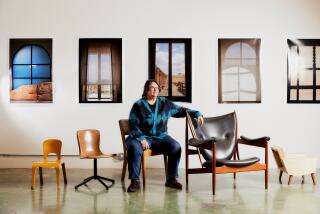SITTING PRETTY
- Share via
Chances are, when you sit in a chair the last thing you think about is its architectural history. Is the chair comfortable? Then it’s a good chair.
But if it weren’t for an international group of designers--dubbed modernists--you would probably be sitting in a very different chair right now.
“Most people, whether they ever think about it or not, somehow imagine that furniture just sort of appears,” says Jimmy Napoli of Palazzetti, a modern furniture design firm in Los Angeles.
“They don’t realize that furniture, like fashion design, architecture and science, is developed through challenging all the little (rules) of the day, like a chair must be round and soft. We owe a lot to the modernists who said, ‘Look, this is my vision, and we’re going to try it this way.’ ”
How did the modern chair evolve? It took a century of refinement and a squadron of designers with skill and courage.
And lots of vision.
Modernism in furniture design is derived from concepts that were developed in the early 20th Century by a group of international architects and interior and furniture designers in the years leading up to World War I. They took hold of a radical new idea: Utility and space function are more important than ornamentation and decoration. Straight lines are good. Less is more.
The industrial revolution changed not only the way people worked, lived and related to one another, but also how they dressed and decorated their homes. The excesses of the Victorian era were tossed out.
The modernist designers were determined that what people sat on would reflect their new-found streamlined lives: if people were now anonymous cogs in the mass-producing wheels of industry, then furniture would likewise be mass-produced and made from modern industrial materials--aluminum, steel, bent plywood, glass, or plexiglass--and would be inexpensive and available to the middle- and lower-income classes.
The movement came to fruition in the late ‘20s with the widely influential Bauhaus school in Germany. The designers who heralded its successes were globally scattered: Charles Rennie Mackintosh in Scotland, Frank Lloyd Wright and Charles Eames in the United States, Eileen Gray and Le Corbusier in France, Gerrit Rietveld in the Netherlands, Marcel Breuer and Mies van der Rohe in Germany and Alvar Aalto in Finland.
The chair became a vehicle for many of these designers to implement their new approach and strategies.
One of the greatest American architects, Frank Lloyd Wright, first worked as a draftsman for the Chicago firm Adler & Sullivan. His revolutionary approach to home design--as well as furniture design--made an early impression on the modernism movement.
Wright had great respect for natural colors and materials, especially wood and stone, and used both in his furniture design, even during the ‘20s and ‘30s when metal and glass were the preferred materials.
An early landmark in Wright’s career and in the story of modern furniture was his cube chair (1895). It is a remarkable design for its time and has been described by his son, John, as “the first piece of modern furniture made in this country.” A small block chair made of angular wood design, it was remarkable in its uncompromising and undecorated angularity.
Most prominent in the early exploitation of metal for furniture was designer Marcel Breuer, who joined the Bauhaus as a student in 1920. Using metal for chairs might seem like an uninspired idea today, but his experiments and ideas were so original that he is often thought of as the proponent of modernism in furniture design. His modular and tubular furniture revolutionized the furniture design industries in America and Europe.
His first chair, the Wassily (1925), is a complex one made of tubular steel and canvas or hide. It has been widely mass-produced since its inception. His cantilever chair (1928), the first cantilever tubular chair, is probably the most classic, mass-produced chair in the modern day.
The Breuer chair (1928) is typical of the time. It was easy to build (bent steel tubing), easy to clean, comfortable, and its modular aesthetic expressed the industrial world that produced it. It is still mass-produced on a large scale today.
Charles Mackintosh is the leading figure in the British modernism movement. His ladder-back chair (1903-1928) is his most distinctive trademark. With it, he changed the way furniture designers used space around and within the chair, making them compositional elements as important as the wood or fabric. In keeping with his native Scottish tradition, stained oak was Mackintosh’s favored wood.
After Ireland’s Eileen Gray transplanted herself to Paris in 1907, she became a highly influential practitioner of the modern movement. Hers was a personal touch that involved Art Deco, functional and machine aesthetics, intelligent use of new materials (cork, aluminum, suede, leather, lacquer), and a fusion of formal and craftsman-oriented skills.
Her sleek and slouchy transit armchair (1927) is considered a Deco-era masterpiece and is being reissued by the Putman Co., an American furniture manufacturer. Place it beside the traditional Victorian-era chair and you’ll see how far she broke the rules to create something better.
A modernist school of furniture design also emerged in the Netherlands. Gerrit Rietveld’s ideology differed from the Bauhaus in that function remained secondary to the resolution of formal, spatial problems. His vision resulted in the influential yet impractical Red-Blue chair (1918), which is more a statement of faith than a modernists’ vision of a brave new world. Even today, it is often found in homes yet is regarded more as a work of art than a chair.
Perhaps the most sophisticated exponent of the austere Bauhaus style was architect Mies van der Rohe. Though his was not the first cantilever chair in the steel tube version, it was the first to carry the principle through to its full potential. In Mr. Chair (1927), he drew the frame in an elegant sweep that exploited the intrinsic flexibility and spring quality of the material.
His Barcelona chair (1929) has a framework of flat steel and cushions of hide. Critics regard it as the supreme statement of Mies’ approach to furniture design. “God,” he maintained, “is in the details.”
Swiss-born architect Le Corbusier designed two chairs in Paris that are acknowledged masterpieces of the modern movement. His most remarkable achievement is the chaise longue (1929), the concept and construction of which were entirely without precedent. The seat frame is contoured to the lines of the body and raised on two arcs and is made in tubular steel covered by fabric or hide seat.
The Grand Confort (1929) is remarkable in that this chair literally turned inside out the traditional design of the deep-upholstered chair, the cushions being contained within the cradle framework rather than serving to conceal it.
A practical idea of modernism--the cantilever chair--was explored in Finland by architect-designer Alvar Aalto. His first revolutionary chair design, scroll chair (1933) adapted the cantilever principle in wood as opposed to steel. Laminated birch provided a balance of flexibility and resilience.
Aalto used wood for “warmth and mellowness to the coldness of metal” and used plywood seats and laminated birch side units, arms, legs and stretchers drawn in one unbroken sweep. The chair was conceived for mass-production, and has spawned imitators over the years.
The circumstances of World War II involved shortages of materials and proved crippling to the furniture industries in America and Europe.
American Charles Eames helped bring about a softer, less overtly dogmatic version of modernism, turning away from the austerity of the Bauhaus look and paving the way for postwar design. He experimented with plywood, fiberglass and light metal, and used his wit and talents to interject the concepts of fantasy and fun in his furniture.
His four-legged base chair (1946) has become a modern classic. Made of plywood walnut veneer of fiberglass-reinforced plastic shell seat and back, with a chrome base, it literally screams of the 1950s and ushered in the contemporary and whimsical look of the 1960s.
Some of the best books on the subject of modernism in furniture design can be found at Rizzoli International Bookstore & Gallery at South Coast Plaza, Costa Mesa. Two introductory books are “Twentieth-Century Furniture” by Philippe Garner and “Furniture by Architects” by Marc Emery.






